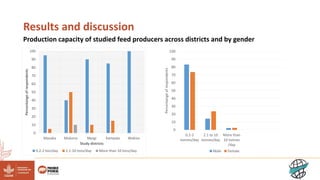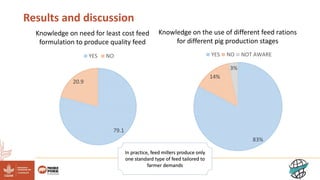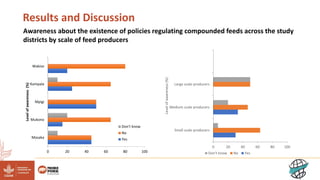Assessing knowledge, attitude, and practices and small-scale commercial feed producers in Uganda
- 1. Assessing knowledge, attitude, and practices and small-scale commercial feed producers in Uganda Ben Lukuyu1, Stella Namazzi2, Pius Lutakome1 and Emily Ouma1 1 International Livestock Research Institute (ILRI), Feeds and Forages Program, Uganda 2 National Agricultural Research Organisation (NARO), National Crops Resources Research Institute, Uganda Tropentag 2021: Towards shifting paradigms in agriculture for a healthy and sustainable future September 15 - 17, 2021, organized by University of Hohenheim, Germany
- 2. 2 Background • About 33 % of the dairy farmers use compounded dairy concentrate feed while nearly 56% use feed ingredients. • The commercial feed industry is dominated by small-scale feed compounders. • Despite an abundance of energy-based and protein-based ingredients, farmers continue to lament about the high prices, poor quality, and limited access to compounded feeds. • To improve the quality of compounded feeds on the market, it is important to understand the knowledge, attitudes, and practices (KAPs) of small-scale feed producers.
- 3. 3 Objectives • To investigate assess the knowledge, attitudes, and practices of small-scale feed producers to identify entry points or key leverage points to improve the small scale commercial compounded feed production in Uganda.
- 4. 4 Material and Methods • Eighty (80) small-scale commercial compound feed producers in three intervention districts of Mukono, Masaka, Kampala, and two control districts of Mpigi and Wakiso were interviewed • The choice of the target and control districts was based on high pig population density (>50 heads/km2) and the high concentration of feed producers. • The data for this study were collected through a cross-sectional survey with feed outlets as the sampling unit using a semi-structured questionnaire programmed in Computer Aided Personal Interviewing technology using Open Data Kit (ODK). • Data analysis was done using SPSS and STATA 15.
- 5. Results and discussion Production capacity of studied feed producers across districts and by gender 0 10 20 30 40 50 60 70 80 90 100 Masaka Mukono Mpigi Kampala Wakiso Percentange of respondents Study districts 0.2-2 ton/day 2.1-10 tons/day More than 10 tons/day 0 10 20 30 40 50 60 70 80 90 100 0.2-2 tonnes/day 2.1 to 10 tonnes/day More than 10 tonnes /day Percentange of respondents Male Female
- 6. Results and discussion Knowledge on the use of different feed rations for different pig production stages 83% 14% 3% YES NO NOT AWARE 79.1 20.9 YES NO Knowledge on need for least cost feed formulation to produce quality feed In practice, feed millers produce only one standard type of feed tailored to farmer demands
- 7. Results and discussion Level of knowledge related to feed supplementation and protein/energy requirements by different gender 0 10 20 30 40 50 60 70 80 90 100 Yes No Don't know Level of knowledge on feed supplementation Male Female 0 10 20 30 40 50 60 70 80 90 100 Male Female Level of knowledge on feed nutrients Gender Knowledgeable Not knowledgeable
- 8. 8 Attitudes of feed producers about pig feeding and use of compounded feeds Feed quality laser fare attitudinal typology Knowledge attitudinal typology Consumer orientated attitudinal typology Profit orientated typology Laboratory analysis is costly Quality of feeds is adjusted based on demand Feed differentiation among different stages is not important Knowledge of composition of feed ingredients is not important in feed production Physical & sensory methods are sufficient for detecting quality I exclusively use sensory for determining quality of feeds I possess vast experience in compound feed mixing Animal nutrition expertise is not important in feed formulation & production Poor quality feeds deters farmers from using it High cost of feed ingredients increases cost of compounded feeds Poor quality compounded feeds affect pig productivity Seasonal variation in costs of feed ingredients affects the market price of compounded feeds Choice of formula is influenced by the price of ingredients but not quality Quality of compounded feeds does not influence sales. Compounded feeds are expensive and farmers cannot afford them Pigs can eat anything irrespective of the nutritive quality
- 9. Results and Discussion Awareness about the existence of policies regulating compounded feeds across the study districts by scale of feed producers 0 20 40 60 80 100 Masaka Mukono Mpigi Kampala Wakiso Level of awareness (%) Don't know No Yes 0 20 40 60 80 100 Small scale producers Medium scale producers Large scale producers Level of awareness (%) Don't know No Yes
- 10. Results and Discussion • Small scale feed producers relied on customer feedback to determine the quality of compounded feeds. • Few feed millers in Uganda analyze feeds for quality due to costs, timeliness, unreliability of results and inadequate engagement with them as clients. Methods used in detecting quality of feed ingredients used in compounding feeds 0 20 40 60 80 100 Percentage using method
- 11. 11 Key messages • Feed millers are aware about importance of formulating high quality least cost pig feed rations by production stages • However, the level on knowledge on feed nutrient compositions is low and mix one standard type of feed tailored to farmer demands. This is attributed to knowledge gap in technical skills among commercial feed producers to formulate and produce high quality compounded feeds. • Farmers have negative perceptions about key aspects that influence good quality of pig feeds • There is low awareness about the existence of policies regulating compounded feeds amongst feed producers • Very few feed producers analyze feed for quality but depend on customer feedback to establish quality of feeds
- 12. 12 Conclusion • The study shows that there are gaps in technical knowledge and practices regarding feed formulation and mixing, and limited awareness about policies and regulation of feed production and marketing of commercial feeds in Uganda.
- 13. 13 Outlook • Future effort should focus on building capacity in technical skills of feed formulation of small-scale feed producers and influencing their behaviour towards mixing good quality feeds that meet the nutritional and safety standards.
- 14. CGIAR Research Program on Livestock The CGIAR Research Program on Livestock aims to increase the productivity and profitability of livestock agri-food systems in sustainable ways, making meat, milk and eggs more available and affordable across the developing world. This presentation is licensed for use under the Creative Commons Attribution 4.0 International Licence. The program thanks all donors and organizations which globally support its work through their contributions to the CGIAR system livestock.cgiar.org CGIAR Research Program on Livestock The CGIAR Research Program on Livestock aims to increase the productivity and profitability of livestock agri-food systems in sustainable ways, making meat, milk and eggs more available and affordable across the developing world. The program thanks all donors and organizations which globally support its work through their contributions to the CGIAR system livestock.cgiar.org
Editor's Notes
- Apologies for not being able to be there in person. I will present results from Nairobi together with my colleague John Mutua, senior research associate at Alliance Bioversity Int and CIAT This research started a few years ago, and is fed from several scientific publications, stakeholder workshops and MSc thesis – summary is in policy brief in your folder We acknowledge the technical review and endorsement by Deogracious Wonekha MAAIF and Derrick Senyonga MWE We will show you why heat stress in pigs is an important issue for Uganda and should feature high on the adaptation agenda, what future heat stress exposure we expect, who will be impacted and how, and what can be done to adapt.













